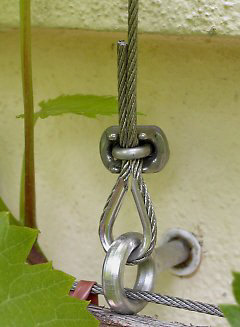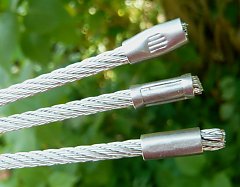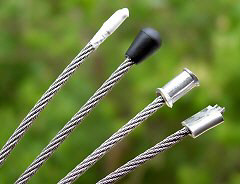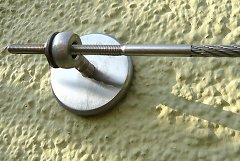Protective End Caps for Cables
With some rope tensioning systems, wire ropes are anchored in 'terminals' at their ends in such a way that no free ends are visible. For cost reasons, FassadenGrün chooses another way and offers systems with visible cable terminations. Since cable ends are sharp and should not unravel (risk of injury), we provide the necessary protective parts for these ends; they are also included in all prefabricated kits. Here you will find detailed information on protecting cable ends. >>> Price list
Back in the Day...
With historical fastening systems -- prior to the existence of wire rope -- 4 mm steel wires (threaded at the ends) were used, passed through an eyelet, and then tensioned tightly by means of a threaded nut. These tension wires were the precursors of the present-day cable tensioning systems.
Tensioning Cable Systems with Terminals
What works with thick wire is problematic when using wire rope: How can the rope end be equipped with a thread? To this purpose, "terminals" were invented. Architectural ropes that have been cut to size are provided with such a terminal on both ends. Analogous to tension ropes, the terminal has an external thread with which the cable is inserted into a mount and tightly tensioned from behind with the help of a threaded nut. In the case of high-grade tensioning cable systems, our competitors often work with sophisticated threaded and fork terminals. They are usually rolled with special machines and are correspondingly expensive. Alternatively, there are do-it-yourself terminals, in which the rope is fixed by grub screws transverse to the fiber direction; the cable end is then virtually part of the threaded rod. But even this solution remains price-intensive.
Therefore, Fassadengrün forgoes terminals altogether and has the ropes tensioned by hand, as described under our section on Installation. But how are the protruding cable ends then protected?
Clean Cut
First, ropes need to be cleanly cut-- preferably with special wire rope cutters. Alternatively, if only a few cutting points are required, the cable can be cut with an angle grinder after marking the cutting points with adhesive tape. cutting line can be marked off with insulating tape and cut with an angle grinder.
End Sleeves
FassadenGrün offers special end sleeves made of stainless steel for cable terminations. These end sleeves (EH 00000) are secured (squeezed) with customary pliers or water pump pliers. The wire rope can either end flush with the end sleeve or protrude 1-2 mm. Different pliers result in different squeeze patterns, all of which have the same effect. After the sleeves have been adequately squeezed, they cannot be removed by hand; their durability in rope tensioning systems is unlimited.
Alternatives
There are a few alternatives (see picture). 1) You can wrap the rope end with duct, insulating, or teflon tape. 2) Somewhat more durable are end sleeves made of plastic or synthetic materials (Note: until further notice, no longer in stock). 3) Even aluminium sleeves are a possibility. These are, however, subject to later electrolytic corrosion.








